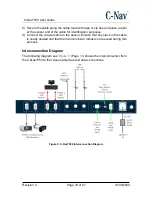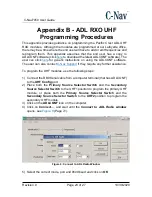
C-Nav7050 User Guide
Revision 0
Page 18 of 27
10/30/2020
Install the antenna with an antenna-mounting pole in the predetermined location.
The pipe can either be welded to the mast for a more permanent installation or
secured using stainless steel hose clamps.
Coaxial Cable Installation
Proper installation of coaxial cables is important to ensure successful
communication between the antenna and sensor.
When choosing a cable route for coaxial cable, consider the following:
Avoid running coaxial cable across, or parallel to power cables and high-power
RF cables.
1) Ensure that the cable route is free of sharp edges or places where the cable
could become pinched, kinked, sliced or damaged in any way.
2)
Determine the manufacturers’ specifications for the coaxial cable in use. This
should include impedance, diameter, attenuation in dB/100 ft and dB/100 m
for the frequencies used, and velocity of propagation.
3) Ensure the cable does not exceed the recommended minimum bend radius
suggested by the manufacturer. LMR400 has a bend radius of 1”
(installation) and 4” (repeated).
4) Ensure there is sufficient space at the cable entry point to the bulkhead as
to not damage the connector during installation.
5) Measure the length of the cable route and determine the acceptable cable
length in relation to attenuation loss at the frequencies in use.
Please Note:
Prior to connecting the coaxial antenna cable to the antenna,
ensure that all connections are free of dirt and other debris. Apply silicone
grease to the connector threads and wipe off any excess, ensure not to get any
lubricant on the contact. Connect the coaxial cable and hand-tighten firmly. Wrap
the connection with self-amalgamating tape or rubber tape and then with vinyl
tape. Cover the taped area with Scotchkote® to prevent water ingress.
6) Slacken the coaxial cable and tape firmly to the antenna-mounting pole. This
will prevent any undue strain on the cable connector and antenna.
7) With the cable connected to the antenna, create a service loop to account
for future re-terminations and run the cable down the mast, securing with zip
ties every 2 or 3 feet. Carefully lay the cable along the chosen route to further
detect any potential kinks, bends or spots where the cable may become
damaged.










































